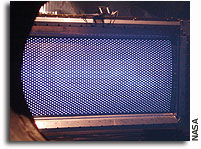
Posted on 11/20/2003 8:11:24 PM PST by Brett66

NASA Successfully Tests Ion Engine
NASA's Project Prometheus recently reached an important milestone with the first successful test of an engine that could lead to revolutionary propulsion capabilities for space exploration missions throughout the solar system and beyond.
The test involved a High Power Electric Propulsion (HiPEP) ion engine. The event marked the first in a series of performance tests to demonstrate new high-velocity and high- power thrust needed for use in nuclear electric propulsion (NEP) applications.
"The initial test went extremely well," said Dr. John Foster, the primary investigator of the HiPEP ion engine at NASA's Glenn Research Center (GRC), Cleveland. "The test involved the largest microwave ion thruster ever built. The use of microwaves for ionization would enable very long-life thrusters for probing the universe," he said.
The test was conducted in a vacuum chamber at GRC. The HiPEP ion engine was operated at power levels up to 12 kilowatts and over an equivalent range of exhaust velocities from 60,000 to 80,000 meters per second. The thruster is being designed to provide seven-to-ten-year lifetimes at high fuel efficiencies of more than 6,000-seconds specific impulse; a measure of how much thrust is generated per pound of fuel. This is a contrast to Space Shuttle main engines, which have a specific impulse of 460 seconds.
The HiPEP thruster operates by ionizing xenon gas with microwaves. At the rear of the engine is a pair of rectangular metal grids that are charged with 6,000 volts of electric potential. The force of this electric field exerts a strong electrostatic pull on the xenon ions, accelerating them and producing the thrust that propels the spacecraft. The rectangular shape, a departure from the cylindrical ion thrusters used before, was designed to allow for an increase in engine power and performance by means of stretching the engine. The use of microwaves should provide much longer life and ion-production capability compared to current state-of- the-art technologies.
This new class of NEP thrusters will offer substantial performance advantages over the ion engine flown on Deep Space 1 in 1999. Overall improvements include up to a factor of 10 or more in power; a factor of two to three in fuel efficiency; a factor of four to five in grid voltage; a factor of five to eight in thruster lifetime; and a 30 percent improvement in overall thruster efficiency. GRC engineers will continue testing and development of this particular thruster model, culminating in performance tests at full power levels of 25 kilowatts.
"This test represents a huge leap in demonstrating the potential for advanced ion technologies, which could propel flagship space exploration missions throughout the solar system and beyond," said Alan Newhouse, Director, Project Prometheus. "We commend the work of Glenn and the other NASA Centers supporting this ambitious program."
HiPEP is one of several candidate propulsion technologies under study by Project Prometheus for possible use on the first proposed flight mission, the Jupiter Icy Moons Orbiter (JIMO). Powered by a small nuclear reactor, electric thrusters would propel the JIMO spacecraft as it conducts close-range observations of Jupiter's three icy moons, Ganymede, Callisto and Europa. The three moons could contain water, and where there is water, there is the possibility of life.
Development of the HiPEP ion engine is being carried out by a team of engineers from GRC; Aerojet, Redmond, Wash.; Boeing Electron Dynamic Devices, Torrance, Calif.; Ohio Aerospace Institute, Cleveland; University of Michigan, Ann Arbor, Mich.; Colorado State University, Fort Collins, Colo.; and the University of Wisconsin, Madison, Wis.
Probably -- but it'd take a megawatt of power to do it....
Note that this put out about 1 N using 12,000 kW of power.
If you scale it up directly from power, 100 N would require 1.2 MW -- where are you gonna generate that?
And to get higher Isp, you're gonna need to pump even more power into it....
The limiting factor here is power generation, and the weight and volume that goes along with it.
Probably the latter. Reactors have a better power/volume ratio -- both we and the Russians have already launched reactors in the 100kW class. Current RTGs only put out about 300W, and it's pretty "low grade" heat -- you'd need a big hunk of plutonium dioxide to put out 100 kW.
It is English. There are over 2 million words in the English language. The average high school graduate knows 20 thousand. Some words require additional study since they have precise technological meaning, and misuse of such words can be expensive. OTOH, misuse of the 2000 words known to be in the vocabulary of most Democrats and Radical Left is deliberate and is intended to create objective confusion.


Disclaimer: Opinions posted on Free Republic are those of the individual posters and do not necessarily represent the opinion of Free Republic or its management. All materials posted herein are protected by copyright law and the exemption for fair use of copyrighted works.